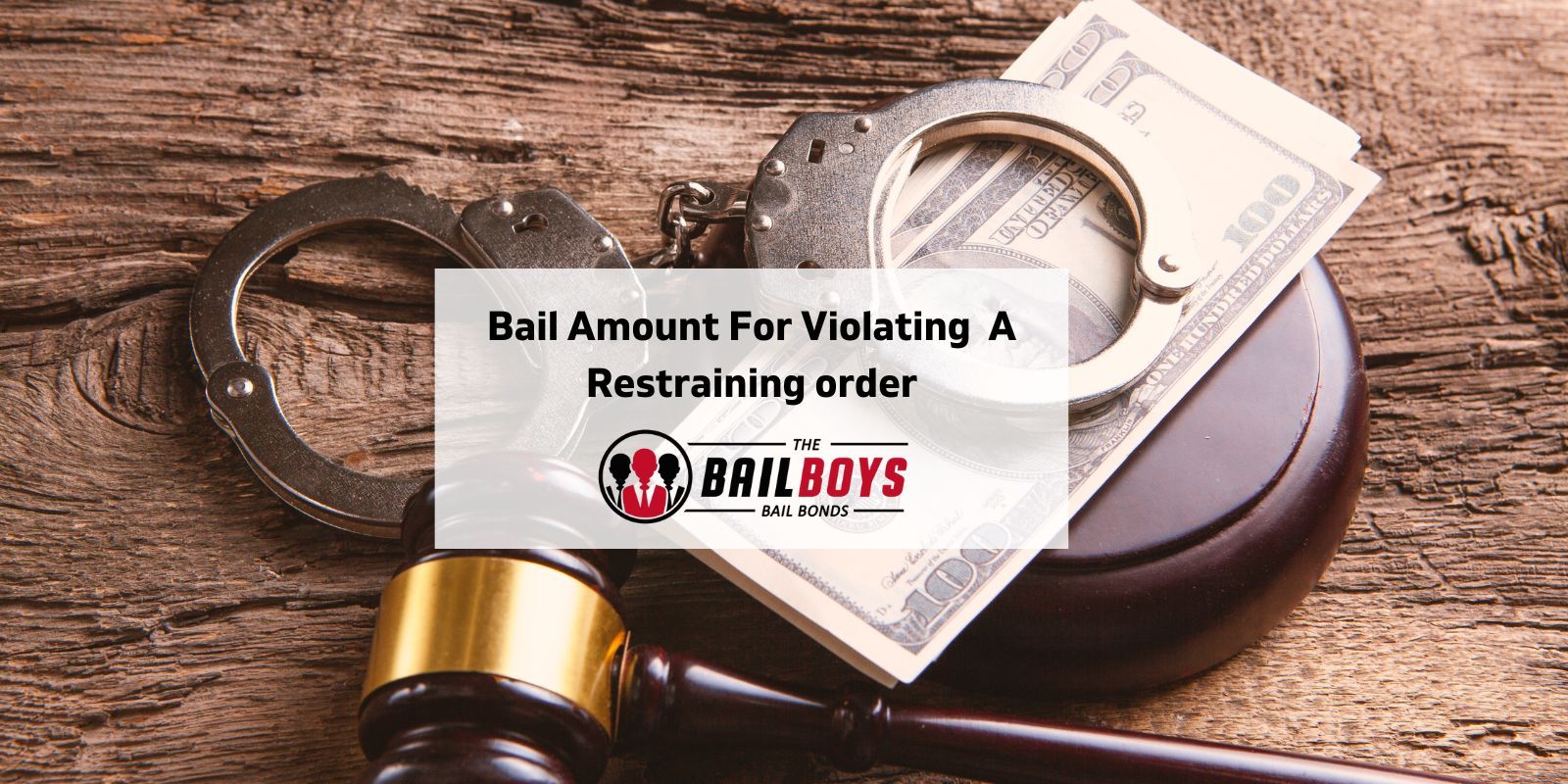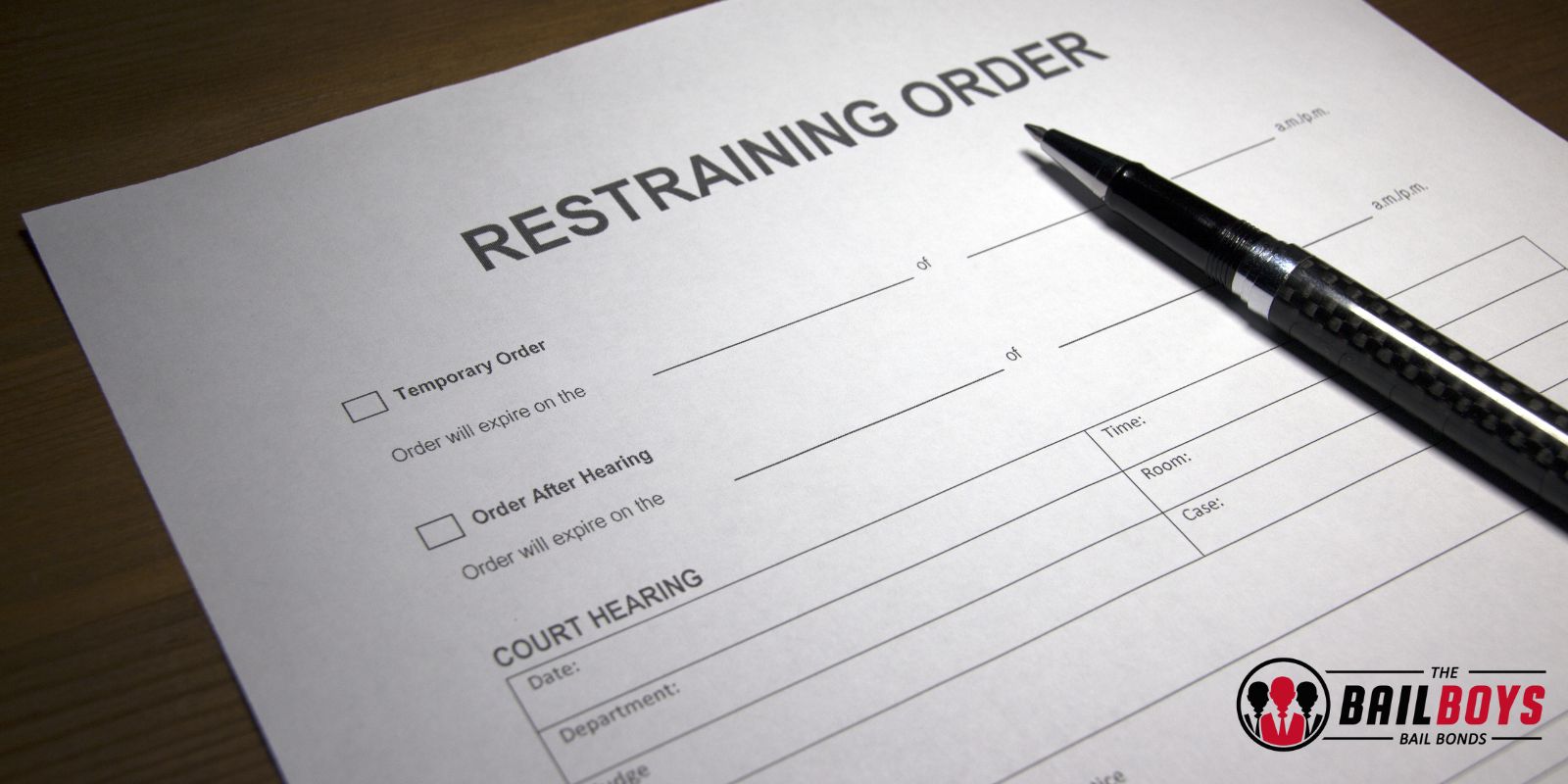
Bail Amount for Violating a Restraining Order
Restraining orders are common in situations where a victim has reasonable evidence that another person is harassing or endangering them. This article explores factors around California restraining orders and the amount one has to pay for bail if they’ve been arrested for breaching the order.
What Is a Restraining Order?
A restraining or protective order refers to a court document that protects one from offensive behavior by another party. The party protected is referred to as a protected person, whereas the defendant is known as a restricted person. In some cases, a restraining order protects more than one party, e.g., children of the primary protected party.
A restraining order protects against physical violence, abuse, threats, and harassment. If someone gets a restraining order against you, California law provides means to notify you. Such means include verbal notice, in-person judicial notice, and a copy of the order mailed to your address.
Can I Go To Jail for Violating a Restraining Order?

Yes. A restraining order is a court order bound by state and federal laws. A person who violates a restraining order will face one or more charges, including the potential of jail time. If the court allows it, defendants can post bail to stay out as they await a hearing.
What Is The Bail Amount for Restraining Order Violation?
The bail amount you pay depends on several factors, including:
- Alleged victims. The judge will likely raise the amount if any party suffered injuries during the crime. The aim is to keep the suspect behind bars to protect the other party.
- Flight risk. If you have the potential to flee the area and avoid the law enforcers, the judge will set a higher bail bond. You are more likely to escape if your crime has extreme consequences or you have ever evaded the police. The higher your flight risk, the more money you will need to pay for the bond.
With an alleged crime, the courts may consider the suspect a danger and will set a very high bail amount.
How Much Is Bail for Violating a Restraining Order?
Bail for a restraining order violation starts at $15 000. Bail bond costs depend on different factors. For example, you’ll face a high bond when your case involves children. Sometimes, the bail bond is too high, and you need help. In such cases, use a bail bondsman who organizes a bond in place of cash bail.
Restraining Orders in California

A restraining order in California contains specific information that determines the level of restriction imposed. For example, in some cases, the order restrains only physical contact and states the closest distance the restricted can get to the protected. Calls, social media interactions, messages, etc., can also be forbidden.
Notification of a Hearing for a Restraining Order
If someone presents an application for a restraining order, the county clerk schedules a court date hearing for the case. The alleged victim must appear in court, but if the defendant fails to appear, the session will still go on. Nonetheless, the judge will make the order without the defendant’s side of the story if the defendant skips court.
Level of California Protective Orders

The various levels of protective orders set different limits on the restricted party. For example, the California department law has two typical levels of restrictions as follows:
- Full stay-away restraining order. As the more restrictive form, a full stay-away order requires the restricted party to avoid any form of contact.
- Peaceful contact order. The order allows both parties to remain in contact with certain limitations.
A judge approves restraining orders based on any behavior that threatens the safety and peace of the other party. The behavior could be done in person or via other means like social media and include the following:
- Damage to the victim’s property, e.g., car or house
- Harassment at social events, home, or workplace
- Non-stop phone calls at any time of the day or night
- etc.
Stay Away Orders
Intimidation, harm, discussion, and the possible occurrence of such situations call for protection. Thus, a judge in a criminal case issues a stay-away order to protect a crime victim or witness. The judge always gives a stay-away order after the defendant faces charges or is found guilty of particular crimes.
Types of Protective Orders and Contact Prohibited
 California has four types of protective orders, as shown in the list below.
California has four types of protective orders, as shown in the list below.
- Domestic Violence Restraining Order
- Civil Harassment Restraining Order
- Elder or Dependent Adult Restraining Order
- Workplace Violence Restraining Order
Yet, the most common is the Domestic Violence Restraining Order (DVRO). DVRO applies to people who’ve dated or had a family before. A restraining order requires that the restricted party avoids different kinds of contact with the protected person. Such include social media, personal interactions, phone calls, texts, and email.
Types of restraining orders
California law provides three restraining orders: emergency, temporary, and permanent. Each applies in different situations and has particular time limits.
Emergency Restraining Order
Emergencies occur when a victim needs immediate relief from an abusive family member. A judge or police officer can also request an emergency DVRO after an allegation of domestic violence. The perpetrator has no involvement in the process but only gets a notice to stay a given distance from the victims.
Temporary Restraining Order
Temporary DVROs apply when the victim wants to seek a full restraining order but needs immediate protection. With insufficient evidence for the charge, the court can deny the DVRO. Similar to an emergency DVRO, a temporary DVRO only lasts for 15 to 21 days and isn’t for emergencies.
Full Restraining Order
The emergency and temporary DVROs protect the alleged victim until the hearing for the restraining order. A full DVRO lasts a long time and could go for up to five years if the judge finds reason to issue one. The order has requirements of what the perpetrator shouldn’t do or prohibited places.
Domestic Violence Restraining Orders (DVRO)

Many DVROs against a spouse or an ex-spouse are valid, but other situations also call for a DVRO. Such situations include:
- Your child’s other parent
- A person you live or once lived with
- A person you are or you once dated
- A close relative like a sibling, parent, grandparent, etc
Domestic Violence in California and Restraining Orders
The court gives a domestic violence restraining order (DVRO) to warn the accused against threats, harm, and harassment. Parties of domestic violence are usually household members and parties in or who were into an intimate relationship. Violations of the DVRO restraining order lead to criminal charges under the penal code 273.6 PC.
The Legal Definition of Domestic Violence
Domestic violence is defined when someone you are related to through marriage or blood does any of the below acts.
- Reckless or willful attempt to cause bodily harm or actual bodily harm
- An act that places someone else in reasonable apprehension of serious physical harm
- Sexual harassment
- Conducts that disturb the emotional or mental calm
- Destruction of personal property
- Activities that threaten or make someone else in danger of serious physical injuries
Domestic violence isn’t limited to the actual infliction of injury or assault. Other topics like custody, safe court processes, and protection orders are within the realm of domestic violence.
What Are Related California Offenses?
The violation of a restraining order is always related to several domestic violence offenses, such as:
- Contempt of court. California laws prohibit you from behaviors disrespectful to court processes, e.g., aggressiveness in court.
- Stalking. You shouldn’t follow, threaten, or harass someone to the point that the other person feels unsafe.
- Domestic violence. Based on California laws, you shouldn’t threaten to harm or harm your intimate partner.
- Criminal threats. One shouldn’t threaten to kill or harm, putting the other person in a state of worry.
- Elder abuse. Financial exploitation, neglect, and physical and emotional abuse go against California laws.
- Vandalism. Malicious damage, destruction, and defecation of someone else’s property is an offense.
How Long Can You Be Notified of an Arrest or Other Violation?
The protected party must report and let law enforcement act upon the report. The court will serve the restricted party an order if the violation occurs due to a lack of knowledge. If the evidence for a willful violation is available, the police find and arrest the restrained party.
How Long Does a Restraining Order Last?
After a court hearing, the judges granted a restraining order for up to five years. The protected party can request an extension if reasons for reasonable fear exist when the period elapses. The extension can go for a further five years or be permanent and doesn’t depend on new incidences of threats.
Restraining Orders in Same-Sex Relationships
A good percentage of same-sex marriages have victims of domestic violence, but many cases go unreported. Common domestic violence in same-sex marriages includes blackmail, withholding resources, and physical violence. Nonetheless, like in other unions, domestic violence victims can also file restraining orders in same-sex marriages.
Can I go To Jail for Violating a Restraining Order?
Violation of a restraining order can either be a misdemeanor or felony based on the situation at hand. A misdemeanor attracts fewer penalties than a felony; for example,
- Counseling for violent behavior or drug abuse
- Up to one-year jail term in the county jail
- Restitution for medical expenses the victim has suffered
A felony attracts more severe consequences, e.g.,
- 16 months to three years in state prison
- Probation and one year or less in the county jail
- A fine of up to $10 000
Can a Victim Violate a Restraining Order?
A protected person can’t violate a restraining order. The court doesn’t restrict them from calling a restrained party. Their communication proves that the protected party isn’t afraid anymore. The court lifts the restraining order.
Are there Immigration Consequences?
Violation of a restraining order doesn’t have any effect on your immigration status. Nonetheless, you remain deportable if you are a non-citizen and violate DVRO. The violation can be due to non-violent actions. Also, if you commit an aggravated felony, you could be marked as inadmissible or deported.
Restrictions Order Violations Bail Bonds
Failure to observe the requirements of a restraining order attracts fines, jail terms, and other penalties. If the order involves children, the bail amount increases and could even be double the required amount. If you, your friend, or your family get arrested for a restraining order violation, the court gives a hearing to set the bond amount.
California Laws on Violating a Restraining Order | Penal Code 273.6
The California law has measures to handle violators of a restraining order. So, the restricted party should always adhere to the conditions of the restraining order. Penal code 273.6 makes violation of restriction orders illegal and can result in arrest and prosecution.
The Crime of Violating a Protection Order in California – Penal Code 273.6
Penal code 273.6 PC stipulates that intentional violation of a protective order attracts a fine, jail term, or both. A typical violation is a misdemeanor and attracts fewer charges than a violation with violence. Examples of violations are when the restrained party:
- Stalks or texts the protected party
- Calls and threatens the protected party
Restrictions Hearings
Whereas restraining orders protect the alleged victim, evidence of threat must exist for a successful process. After the court hearing, the protected party convinces the judges that the evidence is enough for abuse. Whereas a lawyer isn’t mandatory, legal help will increase the chances of a fair outcome.
Does a Conviction Affect Gun Rights?
Convictions affect gun rights because you aren’t allowed to possess firearms under a restriction order. Instead, you must relinquish the guns to the law enforcement body. Alternatively, sell the gun to a licensed dealer.
You could face misdemeanor charges if you retain a gun after a restraining order. Also, if you buy or attempt to buy firearms while under a restraining order, you risk a wobbler offense. Unlawful possession of guns earns you several years in jail.
Restrictive or Protective Order Overview
One of the ideal ways to protect the victims of domestic violence is through a protective order. The order protects spouses, ex-spouses, and other parties close to the offender. Protective measures restrict personal conduct and physical proximity and could require a party to move out.
Can a Restraining Order Be Issued Without The Respondent Knowing The Petitioner?
Some restraining orders protect the protected parties and other people close to those protected. Restraining orders also protect parties with no previous intimate contact with the respondent. Such parties could be neighbors or coworkers the respondent doesn’t need to know.
Are There Legal Defenses To 273.6 PC?
You can use three legal defenses against a restraining order violation charge:
- Unlawful order. The protected party should present evidence that you violated the restraining order. Lack of evidence is insufficient proof that you violated the order.
- Unintentional act. Sometimes, you will meet the protected person within a prohibited distance, especially if you live within the same area. Whereas you shouldn’t leave immediately, you shouldn’t also stay long since you now know that the protected party is around.
- Lack of knowledge. No knowledge defense applies if you weren’t told of or served with the order. A possible scenario is if the restraining order went to the wrong address.
How Does The Prosecutor Prove The Charge?
Under PC 273.6, the prosecutor should prove the below factors to convict you.
- A court issued a legal protective order. A legal basis for the order’s issuance must exist, and the court must have jurisdiction to issue the order.
- You knew the court issued the order. The court can orally state in court terms or serve the restricted party with the order.
- You followed the court order. The court can’t issue charges if you have a mental impairment that makes you lose control over your actions.
- You willfully violated the order. But, sometimes, a violation happens unintentionally. So, the prosecutor must prove that you intentionally violated the order to charge you.
Can a Person Get a Conviction Expunged?
An expungement clears the restricted party of certain misdemeanors or felonies. You are eligible for it if you didn’t get any state prison time. After expungement, your conviction remains in the FBI and other databases, but the records remain closed from public reach.
Do Restraining Orders Appear on Background Checks?
Restraining orders are a civil matter hence don’t always appear on background checks. Nonetheless, in-depth criminal background checks like security or United States military clearance show the orders. Another instance where the order may show up is if the associated cause of the order is a criminal offense.
FAQs
Let’s take a look at some common questions regarding the bail amount for violating a restraining order:
How long do you go to jail for violating a restraining order in california?
Violation can happen in different ways and fall under the categories of felony or misdemeanor. A misdemeanor attracts up to a one-year jail term in the county jail. On the flip side, a felony results in 16 months to three years jail term in the state prison.
What happens if you violate a restraining order in MA?
A restraining order violation in Massachusetts attracts probation and/or jail or 2.5 years in the house of correction. Besides, criminal charges interfere with your ability to get citizenship, a job, or housing. Finally, if you are a non-citizen, you could get deported.
Is PC 273.6 a felony?
PC 273.6 isn’t a felony but a code that specifies actions to be taken against violators of restraining orders. Based on PC 273.6, intentional violation of a protective order is a misdemeanor. The punishments of the breach could be a fine, jail term, or both.
Conclusion
If your friend or family member gets arrested for violation of a restraining order, bail costs can vary. California bail bonds are available to minimize the financial burden. Call The Bail Boys today and get free estimate.


